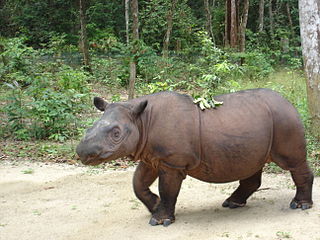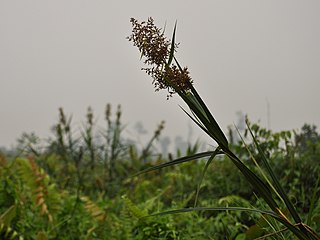Larutia is a small genus of limbless skinks in the family Scincidae.

The Sumatran rhinoceros, also known as the Sumatran rhino, hairy rhinoceros or Asian two-horned rhinoceros, is a rare member of the family Rhinocerotidae and one of five extant species of rhinoceros. It is the only extant species of the genus Dicerorhinus. It is the smallest rhinoceros, although it is still a large mammal; it stands 112–145 cm (44–57 in) high at the shoulder, with a head-and-body length of 2.36–3.18 m and a tail of 35–70 cm (14–28 in). The weight is reported to range from 500–1,000 kg (1,100–2,200 lb), averaging 700–800 kg (1,500–1,800 lb). Like both African species, it has two horns; the larger is the nasal horn, typically 15–25 cm (5.9–9.8 in), while the other horn is typically a stub. A coat of reddish-brown hair covers most of the Sumatran rhino's body.

Dicerorhinus is a genus of the family Rhinocerotidae, consisting of a single extant species, the two-horned Sumatran rhinoceros, and several extinct species. The genus likely originated in the Mid to Late Pliocene of Northern Indochina and South China. Many species attributed to the genus probably actually belong in Stephanorhinus.

Erigeron sumatrensis is an annual herb probably native to South America, but widely naturalised in tropical and subtropical regions, and regarded as an invasive weed in many places. In the British Isles it is known as Guernsey fleabane. Other common names include fleabane, tall fleabane, broad-leaved fleabane, white horseweed, and Sumatran fleabane.

The large bamboo rat, Sumatran rat, or Indomalayan rat is a species of rodent in the family Spalacidae found in Cambodia, China, Indonesia, Laos, Malaysia, Myanmar, Thailand, and Vietnam. It is one of four species of bamboo rat. Individuals can reach lengths of nearly 50 cm (20 in) with a 20 cm (7.9 in) tail, and weigh up to 4 kilograms (8.8 lb).
Tactusa is a genus of moths of the family Erebidae. The genus was erected by Michael Fibiger in 2010.

Scleria sumatrensis, commonly known as nutrush and Sumatran scleria, is a plant species in the sedge family. It is native to temperate and tropical Asia, where it is usually found growing in wetlands, and is considered a noxious weed on the island of Borneo. It has been used in traditional medicine against gonorrhea.

Filopaludina sumatrensis is a species of large freshwater snail with a gill and an operculum, an aquatic gastropod mollusk in the family Viviparidae.

The Northern Sumatran rhinoceros, also known as Chittagong rhinoceros or northern hairy rhinoceros was the most widespread subspecies of Sumatran rhinoceros, as well as the only known subspecies native to mainland Asia.

The Indochinese blue flycatcher is a species of bird in the family Muscicapidae. It is found from southern Myanmar and the Malay Peninsula to Indochina and northeastern Sumatra. It was previously considered conspecific with Tickell's blue flycatcher.

Sphenomorphinae is a large subfamily of skinks, lizards within the family Scincidae. The genera in this subfamily were previously found to belong to the Sphenomorphus group in the large subfamily Lygosominae.
Larutia kecil is a species of skink. It is endemic to Sarawak, Malaysian Borneo, where it is known from Gunung Penrissen. It is a small species within its genus, reaching 84 mm (3.3 in) in snout–vent length.
Larutia larutensis, also known as the black larut skink or Larut Hills larut skink, is a species of skink. It is endemic to Peninsular Malaysia.

Larutia miodactyla, the single finger larut skink or Titiwanga larut skink, is a species of skink. It is endemic to Peninsular Malaysia.
Larutia nubisilvicola is a species of skink endemic to Southern Thailand. It is only known from its type locality in Khao Nan National Park in the Nakhon Si Thammarat Province. It is named after its habitat, cloud forest at about 1,300 m (4,300 ft) above sea level. It occurs on the forest floor, close to the trunks of the larger trees that it uses as refugia.
Larutia penangensis, known as the Penang Island larut skink, is a species of skink. It is endemic to Penang Island, Malaysia.
Larutia puehensis, also known as the Berumput two-toed skink, is a species of skink. It is only known from holotype collected from Gunung Berumput in Pueh Mountains, Sarawak, Malaysian Borneo.
Larutia seribuatensis, also known as the two-lined two-toed skink or Seribuat larut skink, is a species of skink. It is endemic to the Seribuat Archipelago (Malaysia) and occurs on Tioman Island as well as its small neighbor, Tulai Island.
Larutia trifasciata, known as the three-banded larut skink, is a species of skink found in Malaysia.











